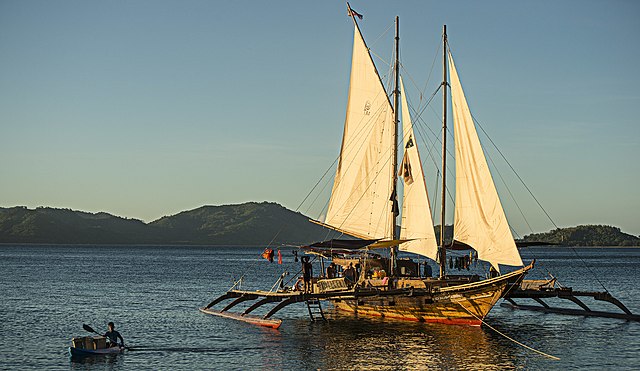Bangka are various native watercraft of the Philippines. It originally referred to small double-outrigger dugout canoes used in rivers and shallow coastal waters, but since the 18th century, it has expanded to include larger lashed-lug ships, with or without outriggers. Though the term used is the same throughout the Philippines, "bangka" can refer to a very diverse range of boats specific to different regions. Bangka was also spelled as banca, panca, or panga in Spanish. It is also known archaically as sakayan.
A small bangka used for transporting passengers of larger boats in Boracay
Balatik, a reconstruction of a large sewn-plank paraw in Palawan
Replica of a balangay, a pre-colonial trading ship excavated from Butuan. These replicas do not include the outriggers.
A paraw in Boracay
A trimaran is a multihull boat that comprises a main hull and two smaller outrigger hulls which are attached to the main hull with lateral beams. Most modern trimarans are sailing yachts designed for recreation or racing; others are ferries or warships. They originated from the traditional double-outrigger hulls of the Austronesian cultures of Maritime Southeast Asia; particularly in the Philippines and Eastern Indonesia, where it remains the dominant hull design of traditional fishing boats. Double-outriggers are derived from the older catamaran and single-outrigger boat designs.
USA-17—a 90-foot-long (27 m) trimaran, type BOR90.
A traditional paraw double-outrigger sailboat (bangka) from the Philippines
An Iranun lanong, a double-outrigger warship from the Philippines used in the navies of the Sultanates of Maguindanao and Sulu from the 18th to late 19th centuries. They were also commonly used for raids and piracy.
The Balatik, a paraw, a functioning replica of a traditional Austronesian sailing trimaran from the Visayas Islands of the Philippines








